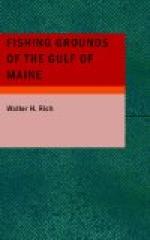[Footnote 14: Capt. John Smith wrote of this region: “Toward the South and Southwest of this Cape (Cape Cod) is found a long and dangerous shoal of sands and rocks. But so far as I incircled it, I found thirtie fadom water aboard the shore, and a strong current; which makes mee thinke there is a Channell about the shoales; where is the best and greatest fish to be had, Winter and Summer in all that Countree. But the Savages say there is no Channell; but that the shoales begin from the main at Pawmet, to the Ile of Nausit; and so extends beyond their knowledge into the sea.” That the captain’s reputation for far-visioned wisdom may not be held too lightly, let these figures speak, taken as they are from the bureau’s records of the landings at the three ports of Boston, Gloucester. and Portland for the year 1927, when the fares from his “Channell” numbered 2,036, with a poundage of 121,688,693 and a value of $3,607,358.]
[Footnote 15. “The earliest record of this name (Saint Georges Shoal) that the writer has found appears upon a map discovered in the library of Simancas, in Spain, where a chart said to have been made by a surveyor sent out to Virginia by James I of England, in 1610, was found in 1885 or 1888, after having long before disappeared from England. This chart is thought to embody, besides the work of Champlain and other foreigners, the information contained in the English charts of White, Gosnold, Pring, and probably of Waymouth’s Perfect Geographical Map. It is thought to have been drawn by Robert Tyndall or Captain Powell.” Genesis of the United States. Alexander Brown.]
OFFSHORE BANKS
Browns Bank. This bank lies in a northeastern direction from Georges and is separated from it by a gully 15 miles wide, in which the depths range from 100 to 450 fathoms. Its area is about 2,275 square miles. The greatest length, from Se to NW, is 63 miles and the greatest width is 43 miles. It is situated between 64 deg. 52” and 68 deg. 29” west longitude, and 41 deg. 50” and 43 deg. 02” north latitude. There is a small rocky shoal on the northern part, on which, it is said, there is not 9 to 15 fathoms. The bank slopes away from the shoal, S. and E. to depths of 55 to 75 fathoms, but at a distance of 12 or 15 miles off, it again rises to 30 to 50 fathoms. This area of shoal water, within the 50 fathom limit, is 50 miles long and has an average width of 15 miles. North of the shoal the water deepens suddenly to 70 and 80 fathoms. The bottom is largely coarse sand, gravel, pebbles, and rocks and is rich in animal life. The area of the bank is approximately 1,370 square geographical miles.
Tides here are quite as strong as on the eastern side of Georges Bank, the ebb having an average strength of 1 1/3 miles an hour and the flood is somewhat stronger. The greatest strength of the flood tide sets W. the ebb in nearly an opposite direction.




